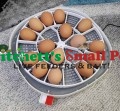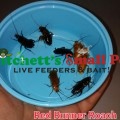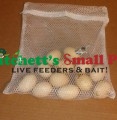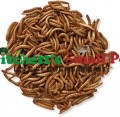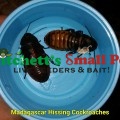 Loading... Please wait...
Loading... Please wait...- Home
- Live Feeders
- Roaches
- Red Runner or Turkistan Cockroach (Blatta lateralis)
Product Description
Distribution: Turkistan, , Middles East, and Now colonies can be found in the wild in the United States
Description: The Turkistan Roach (Blatta lateralis) are a small fast moving roach. They are excellent feeder for animals that want to chase there food. They can not climb glass or plastic at any age but adult males can sort of fly but is more of a controlled fall.
Nick Names: Red Runners, Rusty Reds, Turkistan Roach, Turkestan Roach, Red Runner
Size: 1/8th inch when hatched to 1 inch as adults
Sexing: Adult Blatta lateralis are sexually dimorphic, males have wings and females do not.
Lifespan: 6-12 months
Difficulty Level: Easy
Caging: Blatta lateralis cannot climb glass or plastic. I like to house all of my roaches in rubbermaid or sterlite containers with screened lids.
Substrate: I use egg crates positioned vertically for additional floor/living space in the sterlite tubs. A substrate of peat moss can be used as can other soil mixtures. We do not use a substrate at Pritchett's Small Pets. If you use any kind of substrate from a hardware store or garden center, MAKE SURE IT IS FERTILIZER AND PESTICIDE FREE!
Required Temperatures: 78 - 95 degrees F
Humidity: 40%-50% You can keep a spray bottle handy to help keep humidity up in dry areas. If you use a substrate wetting it down periodically can help maintain proper humidity as well.
Food Requirements: Blatta lateralis will eat almost anything. I keep my home made dry roach food available to them at all times. When feeding any fresh fruits or vegetables, do not put in more then they can eat in 24-36 hour period to avoid problems caused by rotten/moldy food.
Maintenance: Keep food and water available at all times. Clean out the waste as needed. I do not allow the waste to get any deeper then 1/2 of an inch. I also leave some in as the babys seem to do better when they can feed on their parents waste. Since this species lays eggs it is important to remove the ootheca from the waste before disposing of it.
Breeding Notes: Females can lay 1-2 ootheca per month, each containing 20-30 roaches. The ootheca are susceptible to drying out so make sure the humidity stays up. The ootheca will hatch in 2-6 weeks depending on temperature and humidity.


